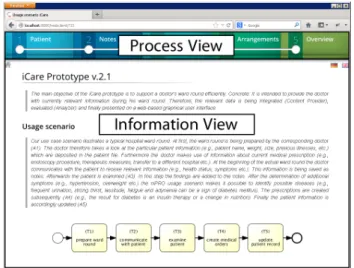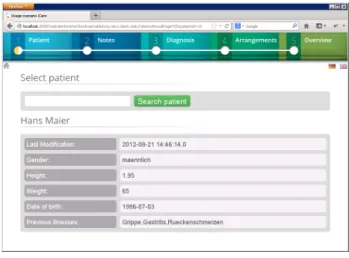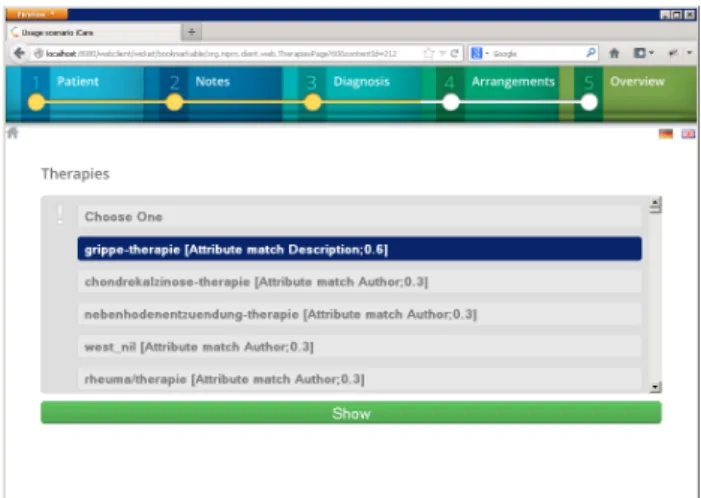iCare: Intelligent Medical Information Logistics
∗Bernd Michelberger
University of Applied Sciences Ravensburg-Weingarten,
Weingarten, Germany
bernd.michelberger@hs- weingarten.de
Armin Reisch
University of Applied Sciences Ravensburg-Weingarten,
Weingarten, Germany
armin.reisch@hs- weingarten.de
Bela Mutschler
University of Applied Sciences Ravensburg-Weingarten,
Weingarten, Germany
bela.mutschler@hs- weingarten.de Jörg Wurzer
iQser AG, Bassersdorf, Switzerland
joerg.wurzer@iqser.net
Markus Hipp
University of Ulm, Institute of Databases and Information
Systems, Ulm, Germany
markus.hipp@uni-ulm.de
Manfred Reichert
University of Ulm, Institute of Databases and Information
Systems, Ulm, Germany
manfred.reichert@uni- ulm.de
ABSTRACT
The diversity and quantity of medical information emerging from patient treatment makes it a challenging task for medi- cal staff to identify and handle the information they need to perform their tasks in the best possible way. The doctor’s ward round, for example, is a knowledge-intensive process comprising complex information-centric tasks such as pa- tient examination and diagnosis. Goal is to provide medical staff with relevant information dependent on their work con- text. This paper picks up this challenge and presents iCare, a semantic application enabling an intelligent integration, analysis, and delivery of personalized medical information.
Categories and Subject Descriptors
H.4.1 [Information Systems Applications]: Office Au- tomation—Workflow Management
General Terms
Documentation, Management
Keywords
information logistics, semantic technology, healthcare
1. INTRODUCTION
The diversity and quantity of medical information emerg- ing in patient treatment and administration makes it a chal-
∗This work was done in the niPRO project, which has been funded by the German Federal Ministry of Education and Research (BMBF) under grant number 17102X10. More information can be found at http://www.nipro-project.org.
Permission to make digital or hard copies of all or part of this work for personal or classroom use is granted without fee provided that copies are not made or distributed for profit or commercial advantage and that copies bear this notice and the full citation on the first page. To copy otherwise, to republish, to post on servers or to redistribute to lists, requires prior specific permission and/or a fee.
iiWAS2013,2-4 December, 2013, Vienna, Austria.
Copyright 2013 ACM 978-1-4503-2113-6/13/12 ...$15.00.
lenging task for medical staff such as doctors and nurses to identify and handle the medical information they need to perform their tasks in the best possible way [8]. During a ward round, for example, doctors have not only to rely on patient records, but also on laboratory reports, and medical knowledge. Generally, the effective and efficient delivery of medical information is a prerequisite to make well-grounded decisions, diagnoses, and treatments.
Today, medical staff is confronted with very limited time.
Existing studies show that doctors, for example, can spend only 7.5 minutes for searching and handling medical infor- mation per patient and ward round [13].
A solution for this problem is iCare. iCare is a web-based Java application relying on semantic technology. The appli- cation’s overall goal is the personalized delivery of medical information to medical staff. Using iCare, medical staff does not need to search for medical information anymore, but is automatically supplied with relevant medical information dependent on their current work context.
Section 2 introduces the iCare scenario. Section 3 presents the application’s main features and shortly discusses tech- nical concepts. Section 4 describes how the application sce- nario can be supported by iCare. Section 5 discusses related work. Section 6 concludes with a summary and an outlook.
2. SCENARIO
The iCare application scenario has been developed based on results of an exploratory case study we performed at a large German university hospital [8]. The focus of our study was the analysis of an unplanned, stationary hospitalization, including patient admission, medical indication in the anes- thesia, surgical intervention, post-surgery treatment, patient discharge, and financial accounting in a hospital.
iCare specifically aims at supporting the doctor’s ward round (cf. Fig. 1). First, the ward round is prepared, i.e., the doctor looks at patient information (e.g., name, pre-existing diseases) and medical orders (e.g., prescribed drugs, current therapy) (task T1). The doctor then commu- nicates with the patient and asks for additional information about his health status (task T2). This information is docu- mented. Afterwards, the patient is examined (task T3) and patient information (e.g., pulse rate) is updated accordingly.
Finally, the doctor reflects the patient’s status and, depend- ing on his assumptions, gives medical orders (e.g., on the procurement of drugs) (task T4). Again, patient informa- tion and medical orders are updated (task T5). Though this process may vary across different hospitals and even within one hospital, it can be found in every hospital.
Hospital Doctor
prepare ward round
(T1)
communicate with patient
(T2)
examine patient (T3)
create medical orders
(T4)
update patient information
(T5) Patient
Record Notes Onmeda Medical
Orders Notes Medical
Orders
Patient Record
Figure 1: The doctor’s ward round (BPMN model).
For each of the tasks shown in Fig. 1, a variety of hetero- geneous medical information is needed, e.g., patient records, notes, medical orders, laboratory reports, medical guide- lines, and patient protocols. This medical information is typically stored in widespread sources, for example, in hos- pital information systems, medical databases, applications, and libraries. iCare collects and integrates such distributed information, at least as long as it is electronically available.
3. APPLICATION
iCare1 is a web-based semantic Java application based on the semantic middleware iQser GIN server 1.6 [15], the build automation tool Maven, the web framework Wicket 1.5.6, the JavaScript library jQuery 1.72, the database MySQL 5, the text search engine library Lucene 2.4, HTML5, and CSS3. The home screen of iCare (cf. Fig. 2) shows the tasks as introduced in Section 2.
Figure 2: Home screen of iCare.
The user interface of iCare is divided into two parts: the process view and theinformation view. The former illus- trates the currently executed process (i.e., the doctor’s ward round), whereas the latter shows the corresponding medical information (e.g., patient records, laboratory reports, med- ical orders, notes). iCare works both in desktop browsers and on mobile devices.
1A screencast presenting the iCare application is available at http://nipro.hs-weingarten.de/screencast.
3.1 Features
The main features of iCare are theintegrationandanaly- sis of medical information as well as thedelivery of needed medical information to medical staff:
• iCare enables the integration of structured, semi-struc- tured, and unstructured electronically available medi- cal information from different data sources.
• iCare enables the automatic syntactic and semantic analysis of medical information to determine semantic relationships from which medical staff can derive and generate new medical knowledge.
• iCare enables the delivery of needed medical informa- tion to medical staff and represents a central access point and unified view on medical information.
3.2 Technical Architecture
The iCare application is based on a four-tier architecture comprising a data layer, a semantic integration layer, a con- text layer, and an application layer (cf. Fig. 3).
Application Layer Context Layer Semantic Integration Layer
Data Layer
Figure 3: Architecture of iCare.
Thedata layer concerns the set of data sources to be inte- grated (e.g., hospital information systems, databases, digital libraries, medical guidelines, health records, shared drives etc.). For each data source, a so called ContentProvider2 is implemented. Its main task is to transform proprietary medical information into a generic and uniform information format. This is a necessary prerequisite for the subsequent syntactic and semantic analysis.
Thesemantic integration layer, in turn, is responsible for the syntactic and semantic analysis of medical information.
For this purpose, we use the semantic middleware iQser GIN server [15]. Syntactic and semantic analysis is performed in several steps. In a first step, basic attributes of integrated information such as authorships are compared (∼syntactic analysis). This allows, for example, to link information with the same author (e.g., a specific doctor). Second, the raw full text of all available information is analyzed (∼semantic analysis). For this purpose, algorithms from the fields of data mining, text mining (e.g., text preprocessing, linguistic preprocessing, clustering, classification, information extrac- tion), pattern-matching, and machine learning (e.g., super- vised learning, unsupervised learning, reinforcement learn- ing, transduction) are applied [14]. Goal is to further classify and group correlated information. Finally, user behavior is investigated, for example, the frequency of using certain in- formation in the context of specific process tasks.
The result of the analysis is a semantic information net- work (SIN), a labeled and weighted digraph representing
2These ContentProviders are available as open-source plug- ins at http://sourceforge.net/directory/?q=iqser.
information and their semantic relationships [10]. In partic- ular, the SIN allows identifying information linked to each other in the one or other way, e.g., information addressing the same topic (e.g., ”flu”) or needed when performing a particular process task (e.g., ”prepare ward round”) [7].
Thecontext layer is responsible for integrating and ana- lyzing context information (e.g., used device, location, time, user behavior). In [9], we have described a framework realiz- ing the context layer. Context information is gathered from data sources called sensors. We distinguish between physical sensors (e.g., thermometer), virtual sensors (e.g., keyboard input), and logical sensors (e.g., sensors which allow to de- tect a doctor’s position by analyzing logins at devices and a mapping to locations). In addition, further context in- formation can be also derived from existing one (e.g., by aggregation or reduction). A context model (CM), which is constructed based on available context information, al- lows characterizing a doctor’s work context which can then be used to filter the SIN. Note that the CM is completely independent from the SIN, i.e., context information is only stored in the CM but not in the SIN (see [9] for details).
Finally, the application layer concerns the personalized delivery of medical information. The application layer is responsible for the joint presentation of executed processes (or tasks) and corresponding medical information.
Further details regarding the layers can be found in [10].
4. SCENARIO SUPPORT
In the following we describe how the scenario from Section 2 can be supported by iCare. To support task T1, a search box is offered to select single patients. After having selected a patient, iCare provides available information such as name, pre-existing diseases, gender, weight, and date of birth, from the respective patient record (cf. Fig. 4).
Figure 4: Process step 1.
When performing task T2, existing medical notes for the previously selected patient are shown, i.e., information about the patient’s health status (cf. Fig. 5). Upon need, the doc- tor can add, update, or delete medical notes.
Based on an analysis of available medical information, po- tential diseases and treatment options are then automati- cally determined when performing task T3 (cf. Section 3.2 for details). For example, the analysis takes into account the patient record, medical notes, and medical information
Figure 5: Process step 2.
from Onmeda3 and can automatically conclude that sore throat, croakiness, rheumatic pains and absence of appetite are potentially caused by the disease ”flu” (cf. Fig. 6).
Figure 6: Process step 3a.
As an additional result of the syntactic and semantic anal- ysis, the doctor is also supplied with treatment options which are also automatically determined (cf. Fig. 7). If a treat- ment option is selected, a more detailed treatment descrip- tion and respective instructions are displayed.
In task T4, the doctor can then add or update medical or- ders. Finally, the patient record, medical notes, and medical orders can be updated in task T5.
In summary, iCare supports the doctor’s ward round by reducing the time for searching and handling medical infor- mation. iCare automatically delivers needed medical infor- mation depending on the current work context.
5. RELATED WORK
Medical guidelines have been intensively discussed in re- cent years as an approach to support medical decision-ma-
3Since we have no access to international digital medi- cal libraries we use the German health portal Onmeda (http://www.onmeda.de) instead. Therefore, some screen- shots contain German text.
Figure 7: Process step 3b.
king. Burgers et. al [1], for example, discuss and compare structures of medical guidelines. Fervers et. al [2] conduct a survey on the adoption of medical guidelines in health- care practice. The exchange and representation of med- ical guidelines in machine-interpretable form is addressed by Ohno-Machado et. al [11] and Fox et. al [3]. Their work has been of great importance when we developed iCare and its underlying SIN (which also integrates medical guide- lines in machine-interpretable form). However, though med- ical guidelines, like iCare, address medical decision-support, they cannot be directly compared with iCare. Instead, med- ical guidelines can be considered as an additional source of information for iCare (summarizing and documenting well- established medical procedures).
Besides iCare, a large variety of technical tools, platforms and solutions have been introduced to support medical deci- sion-making or other closely related healthcare application scenarios. Due to space limitations, we can only briefly sketch important approaches. Hospital Information Systems (HIS), for example, are large enterprise information systems enabling the management of both administrative and med- ical information (for an overview see Shortliffe & Cimino [12]). Unlike a HIS, iCare is a much more specific appli- cation supporting only one use case, namely the doctor’s ward round. Other specific tools concern the management and utilization of electronic medical records. GNUmed [6], GNUHealth [5], or FreeMED [4] are examples of such tools.
However, note that all these approaches do not include a semantic analysis of medical information and their context- aware delivery to medical staff.
6. SUMMARY AND OUTLOOK
This paper presents our iCare application, a semantic ap- plication enabling the intelligent integration, analysis, and delivery of medical information. The main goal of iCare is to intelligently deliver medical information (e.g., patient records, medical orders, laboratory reports, medical guide- lines) to doctors during their daily ward round.
Future work includes the integration of additional data sources (e.g., medical databases, health portals), the support of additional application scenarios (e.g., the procurement of drugs), and the improvement of information delivery (e.g., by additional syntactic and semantic analysis).
7. REFERENCES
[1] J. S. Burgers, R. Grol, N. S. K. an M. M¨akel¨a M, and J. Zaat.Towards Evidence-based Clinical Practice: An International Survey of 18 Clinical Guideline
Programs. in: J. for Quality in Health Care 2003, 15(1), pp. 31-45, 2003.
[2] B. Fervers, J. S. Burgers, M. C. Haugh, J. Latreille, N. Mlika-Cabanne, L. Paquet, M. Coulombe, M. Poirier, and B. Burnand.Adaptation of Clinical Guidelines: Literature Review and Proposition for a Framework and Procedure. in: J. for Quality in Health Care 2003, 18(3), pp. 167-176, 2006.
[3] J. Fox, N. Johns, C. Lyons, A. Rahmanzadeh, R. Thomson, and P. Wilson.PROforma: A General Technology for Clinical Decision Support Systems. in:
Computer Methods and Programs in Biomedicine, 54(1-2), pp. 59-67, 1997.
[4] FreeMED. http://freemedsoftware.org, June 2013.
[5] GNUHealth. http://health.gnu.org, June 2013.
[6] GNUmed. http://www.gnumed.org, June 2013.
[7] B. Michelberger, B. Mutschler, M. Hipp, and M. Reichert.Determining the Link and Rate Popularity of Enterprise Process Information. in:
Proc. 21st Int’l Conf. on Cooperative Information Systems (CoopIS 2013), pp. 112-129, Graz, 2013.
[8] B. Michelberger, B. Mutschler, and M. Reichert.On Handling Process Information: Results from Case Studies and a Survey. in: Proc. 2nd Int’l Workshop on Empirical Research in Business Process Management (ER-BPM’11), pp. 333-344, Clermont-Ferrand, 2011.
[9] B. Michelberger, B. Mutschler, and M. Reichert.A Context Framework for Process-oriented Information Logistics. in: Proc. 15th Int’l Conf. on Business Information Systems (BIS’12), pp. 260-271, Vilnius, 2012.
[10] B. Michelberger, B. Mutschler, and M. Reichert.
Process-oriented Information Logistics: Aligning Enterprise Information with Business Processes. in:
Proc. 16th IEEE Int’l EDOC Conf. (EDOC’12), pp.
21-30, Beijing, 2012.
[11] L. Ohno-Machado, J. H. Gennari, S. N. Murphy, N. L.
Jain, S. W. Tu, D. E. Oliver, E. Pattison-Gordon, R. A. Greenes, E. H. Shortliffe, and G. O. Barnett.
The Guideline Interchange Format: A Model for Representing Guidelines. in: J. of the Am. Medical Informatics Association, 5(4), pp. 357-372, 1998.
[12] E. H. Shortliffe and J. J. Cimino.Biomedical Informatics: Computer Applications in Health Care and Biomedicin. Springer, 2006.
[13] H. Weber, M. St¨ockli, M. N¨ubling, and W. A.
Langewitz.Communication during ward rounds in Internal Medicine: An analysis of
patient-nurse-physician interactions using RIAS. in:
EACH Conference, 67(3), pp. 343-348, Basel, 2007.
[14] J. Wurzer.New Approach for Semantic Web by Automatic Semantics. in: Proc. 2nd European Semantic Technology Conf. (ESCT’08), Vienna, 2008.
[15] J. Wurzer and B. Mutschler.Bringing Innovative Semantic Technology to Practice: The iQser Approach and its Use Cases. in: Proc. 4th Int’l Workshop on Applications of Semantic Technologies (AST’09), pp.
3026-3040, L¨ubeck, 2009.


